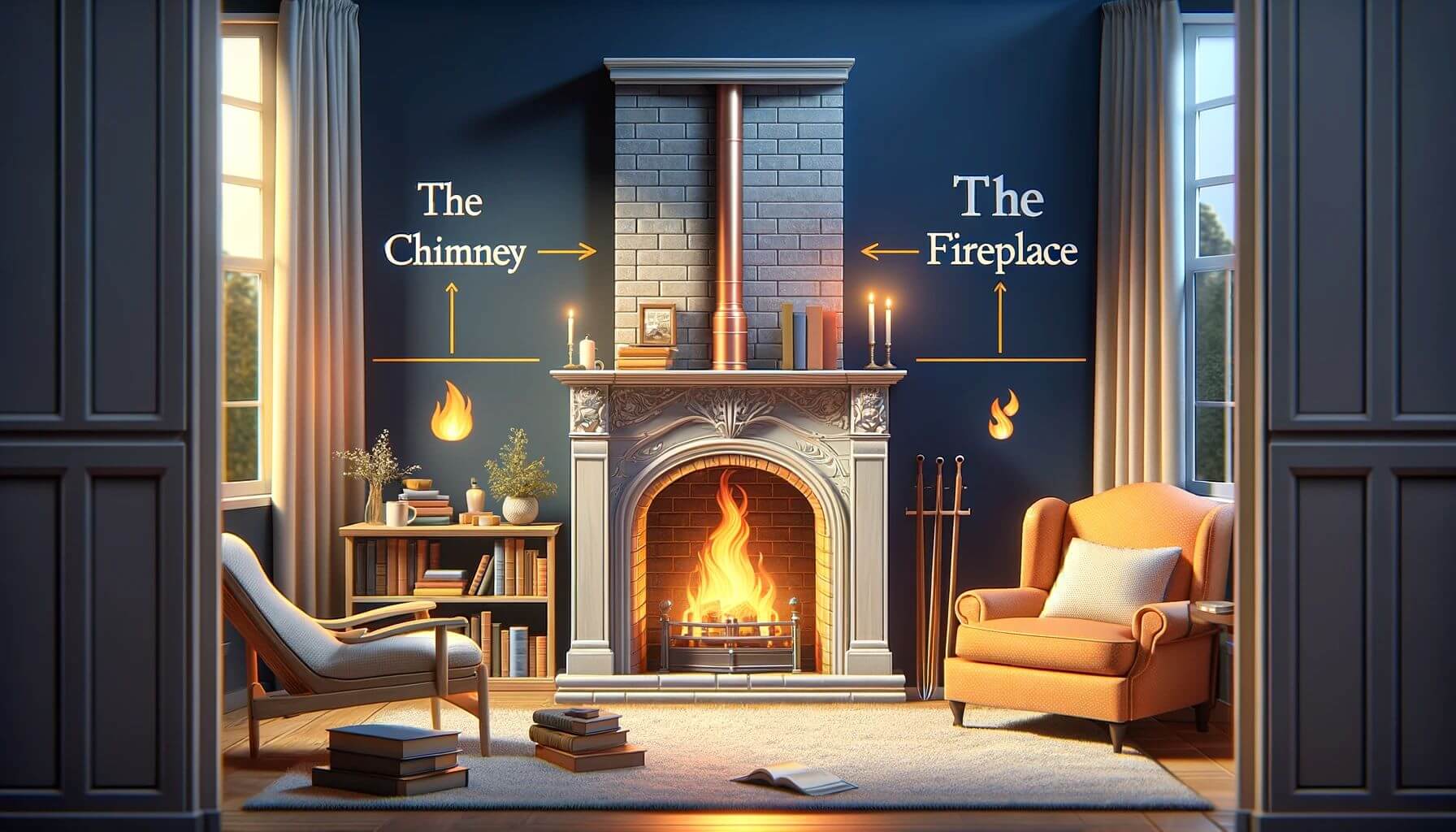
GWS Masonry Services
For centuries, fireplaces and chimneys have been essential components of homes, serving both functional and aesthetic purposes. They are more than just architectural elements; they symbolize warmth, comfort, and gathering. The fireplace provides warmth and a cozy ambiance of a house, while the chimney serves as a vital structural part ensuring safety and proper ventilation.
The history of fireplaces and chimneys is a testament to human ingenuity in domestic comfort and safety. In ancient times, homes had central fires with openings in the roof for smoke to escape. However, this method was inefficient and often hazardous. The evolution of fireplaces and chimneys began as an effort to address these issues, leading to significant architectural developments.
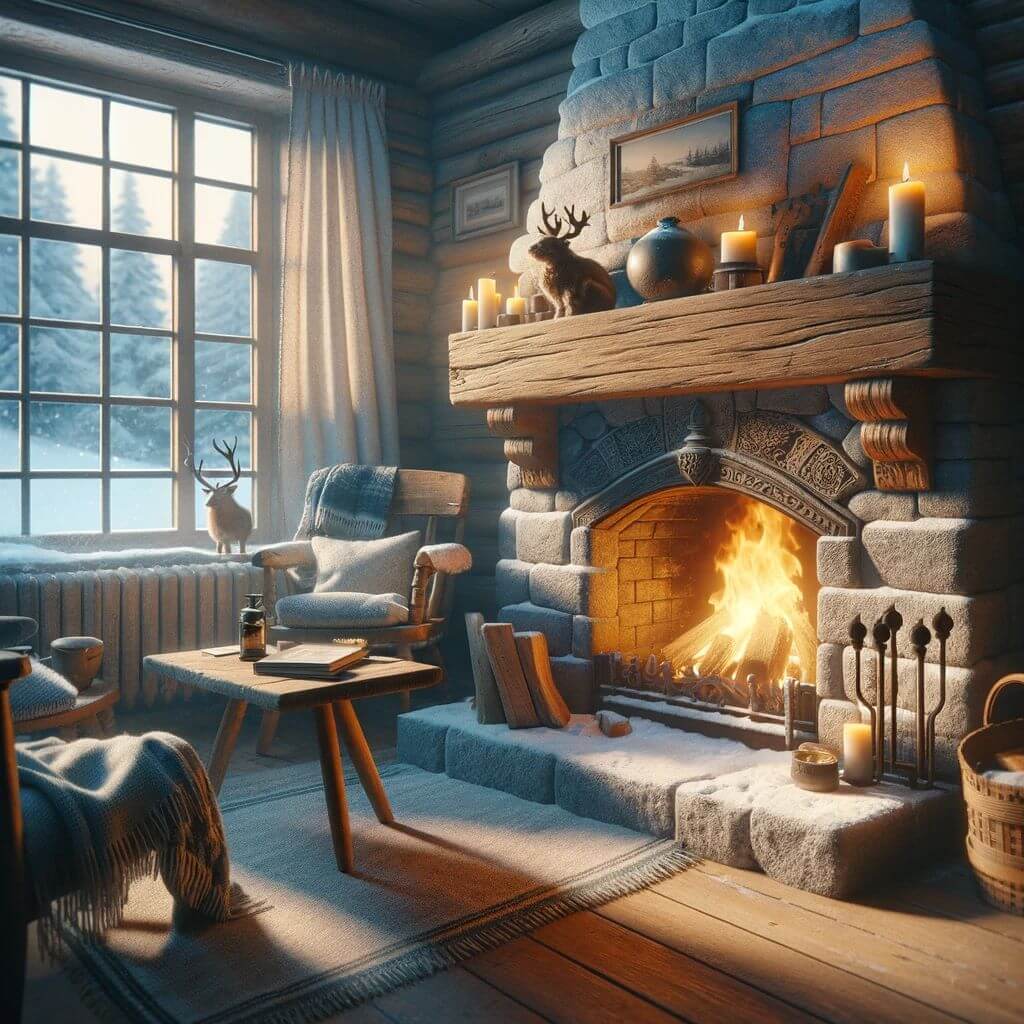
Concept of a chimney, as we know it today
The concept of a chimney, as we know it today, emerged around the 12th century in Europe. This innovation drastically improved air quality inside homes by efficiently channeling smoke outside.
Over time, the design of fireplaces and chimneys became more sophisticated, reflecting the architectural and artistic trends of each era. The grand fireplaces of the medieval castles, the ornate designs of the Victorian era, and the sleek, modern fireplaces of today each tell a story of cultural and technological evolution.
Fireplaces transitioned from being purely utilitarian to becoming central pieces in interior design. From the large, open hearths used for cooking and heating in medieval times to the decorative, heat-efficient units in modern homes, fireplaces have continually adapted to the needs and tastes of the times.
Chimneys, too, have evolved in design and functionality. Initially, they were simple structures, but advancements in engineering led to the development of flues, liners, and caps, enhancing safety and efficiency.
Today, fireplaces and chimneys are not only about warmth and comfort but also about adding character and value to a home. They have adapted to modern needs with innovations in energy efficiency and environmental friendliness, incorporating new fuels and technological advancements while maintaining their timeless appeal.
Understanding the Fireplace

A fireplace, fundamentally, is an architectural structure designed to contain a fire, used historically for heating a room. The basic function of a fireplace is to provide heat; however, its role extends far beyond this utilitarian aspect. In many homes, the fireplace is a source of ambiance, comfort, and warmth, creating a cozy, inviting atmosphere.
The primary purpose of a fireplace has always been to generate warmth, especially in colder climates and during winter months. Before the advent of modern heating systems, fireplaces were the primary source of heat in homes. They were strategically placed in living areas, bedrooms, and kitchens, serving not just as heating elements but also as cooking spaces in some instances.
Aesthetic Value of a Fireplace
Beyond their functional role, fireplaces hold significant aesthetic value. They often become the focal point of the room, around which furniture is arranged and family gatherings are centered. The design of a fireplace can vary greatly, from simple and understated to ornate and grand, reflecting the architectural style of the home and the tastes of the homeowners.
In many architectural designs, the fireplace is used as a tool to enhance the overall aesthetic appeal of a space. It adds a sense of architectural character and can be a showcase of craftsmanship, especially with the use of decorative mantels, unique tiling, and artistic finishes.
The aesthetic appeal of a fireplace extends to its ability to create a warm, inviting ambiance. The crackling sound of burning wood, the soft glow of embers, and the dance of flames all contribute to a sense of comfort and relaxation. This is why fireplaces are often a key element in creating a cozy and welcoming atmosphere in a home.
Fireplaces in Modern Homes
In modern homes, fireplaces have evolved to fit various design preferences and functional needs. From traditional wood-burning fireplaces to gas and electric ones, the evolution of fireplace designs continues to balance between functionality, energy efficiency, and aesthetic elegance.
Thus, the fireplace in a home is more than just a heating apparatus; it is a blend of function, art, and tradition. It provides warmth, serves as a gathering spot, and enhances the aesthetic appeal of a living space, making it a cherished feature in many homes.
Differents Parts of a Fireplace
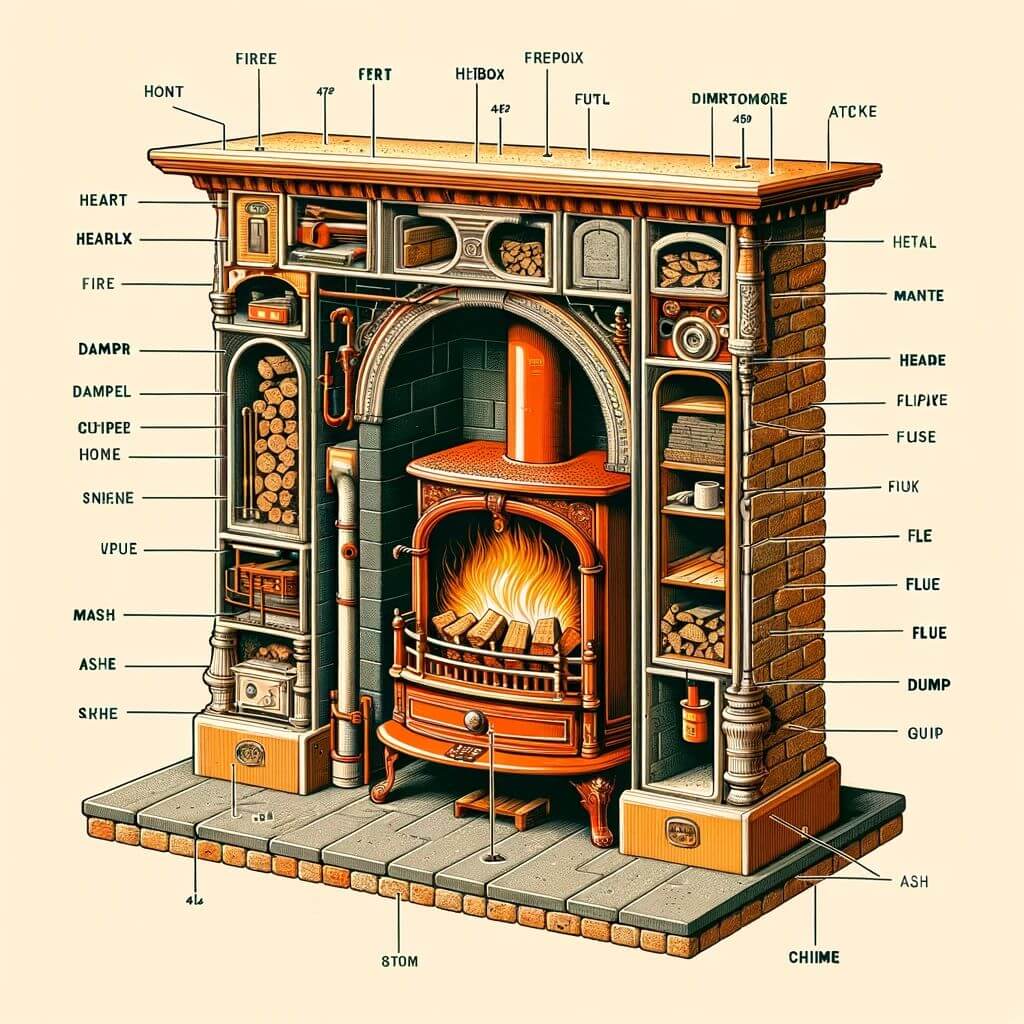
Firebox: The Combustion Chamber
The firebox is the central component of a fireplace where the fire actually burns. It’s a specially designed chamber typically made of firebrick or metal, built to withstand high temperatures. The size and shape of the firebox are critical for the efficient burning of wood and the effective production of heat.
The firebox’s design ensures safe combustion while maximizing heat output. Its insulation properties keep the heat within the fireplace, radiating warmth into the room.
Hearth: The Floor Section of the Fireplace
The hearth is the floor of the fireplace, extending into the room and providing a non-combustible area around the fire. It’s a crucial safety feature that protects the floor from heat and prevents embers or sparks from causing a fire hazard.
Traditionally made from stone or brick, the hearth also adds to the aesthetic appeal of the fireplace. It can be designed to complement the style of the room and the fireplace itself.
Mantel: Decorative Framework and Shelf
The mantel is the decorative framework around the fireplace, often extending to include a shelf. Originally designed to catch smoke and soot, mantels have evolved into elaborate decorative elements that frame the fireplace.
Mantels can range from simple, contemporary designs to ornate, sculptural pieces, reflecting the architectural style of the home. They often serve as a display space for art, photographs, or seasonal decorations.
Ash Dump Door: For Ash Removal
Many fireplaces include an ash dump door located in the floor of the firebox. This feature allows for easy removal of ashes and contributes to the overall maintenance and cleanliness of the fireplace.
The ash dump door leads to an ash pit, where ashes accumulate and can be removed periodically, usually from the basement or outside the house.
Damper: Regulates Airflow and Smoke
The damper is a movable plate located in the flue (the chimney’s inner channel), used to regulate the draft and the flow of smoke and gases. It’s essential for controlling the intensity of the fire and the rate of burning.
When the fireplace is in use, the damper is opened to allow smoke to escape. When the fireplace is not in use, closing the damper prevents cold air from entering the home and warm air from escaping.
The Anatomy of a Chimney
The chimney is a critical component of the fireplace system, serving as the passageway for smoke and combustion gases from the fireplace to the outside. Understanding the anatomy of a chimney is essential for proper maintenance and safety.

Differents Parts of a Chimney
Chimney Structure
The chimney is typically a vertical structure made of masonry or metal, designed to draw smoke and gases safely out of the house. Its design, height, and location are critical for effective smoke evacuation and adherence to safety regulations.
Flue: The Inner Channel for Smoke and Gases
The flue is the inner channel within the chimney through which smoke and gases rise and exit the building. Flues can be made of different materials, including clay tiles, metal, or lined with heat-resistant liners.
The size and shape of the flue are crucial for the efficient and safe removal of combustion products. An improperly sized flue can lead to poor draft and the accumulation of dangerous gases like carbon monoxide.
Liner: Protects the Chimney Walls
A chimney liner, typically made of clay, ceramic, or metal, lines the inside of the flue. Its primary purpose is to protect the chimney walls from heat and corrosion and to provide a smooth, unobstructed path for smoke and gases.
Liners also improve the efficiency of the chimney by maintaining optimal temperatures for combustion gases to rise through the flue.
Smoke Chamber: Connects Firebox to the Flue
The smoke chamber sits above the firebox and below the flue. It allows smoke to collect and rise smoothly into the flue. The design of the smoke chamber is vital for minimizing turbulence and improving the flow of smoke and gases.
A well-designed smoke chamber reduces the risk of backdraft and ensures that the fireplace operates efficiently and safely.
Chimney Cap: Prevents Debris and Moisture Entry
Located at the top of the chimney, the chimney cap is a protective cover that prevents rain, snow, debris, and animals from entering the chimney. It usually includes a mesh screen to stop sparks and embers from escaping and causing roof fires.
Chimney caps are essential for preventing water damage, which can lead to deterioration of the chimney structure and flue.
Crown: Seals the Top of the Chimney
The chimney crown is a concrete or mortar layer that sits atop the chimney, sealing it around the flue liner. It’s sloped to direct water away from the flue and protect the chimney from water penetration, which can cause structural damage.
A properly constructed and maintained chimney crown is vital for the long-term integrity of the chimney structure.
Together, these components ensure that the chimney functions safely and efficiently, removing combustion products from the fireplace and preventing potential hazards. Regular inspection and maintenance of these parts are crucial to the overall safety and effectiveness of the fireplace and chimney system.
Additional Components and Their Functions
In addition to the primary components, a fireplace and chimney system includes several additional features, each serving a specific function to enhance efficiency, safety, and maintenance. Understanding these elements is crucial for comprehensive fireplace care.
Cleanout Door: For Removing Debris
The cleanout door is a small door located at the base of the chimney or in the smoke chamber. It provides access to the chimney interior for cleaning and removing debris, soot, and ash that accumulate over time.
Regular use of the cleanout door for maintenance helps prevent blockages in the chimney, ensuring efficient airflow and reducing the risk of chimney fires.
Spark Arrestor: Prevents Sparks from Exiting the Chimney
A spark arrestor is a mesh screen fitted at the top of the chimney or chimney cap. Its primary function is to prevent hot embers or sparks from escaping the chimney and potentially igniting the roof or nearby combustible materials.
Spark arrestors are especially important in regions prone to wildfires or in homes with wood shake roofs, where stray sparks can pose a significant fire hazard.
Flashing: Seals the Area Where the Chimney Penetrates the Roof
Flashing is a sheet metal installation used where the chimney intersects with the roof. It creates a watertight seal to prevent water from entering the home through the chimney-roof junction.
Properly installed and maintained flashing is critical to prevent water damage, which can lead to costly repairs and structural issues in both the chimney and the roof.
Air Supply Vent: For Combustion Air in Modern Fireplaces
In modern airtight homes, an air supply vent is often necessary to ensure that the fireplace receives enough outside air to support combustion. This vent is typically installed in the firebox or nearby wall.
The air supply vent prevents the fireplace from drawing air from inside the home, which can lead to inefficiency and potential negative pressure issues. It’s particularly important in homes with exhaust fans or other appliances that can create a vacuum effect.
Types of Fireplaces and Their Unique Parts

Fireplace chimney comes in various types, each with its unique components and features. Understanding these differences is crucial for proper use, maintenance, and making an informed choice about which type suits your needs best.
Traditional Wood-Burning Fireplaces
- Construction: Typically built with a firebox, hearth, chimney, and flue. They require a sturdy foundation to support the weight of the chimney and firebox.
- Unique Parts: Ash dump door for removing ashes, a damper to control airflow, and often a smoke shelf to help with the efficient exit of smoke.
- Features: Provide the authentic experience of crackling wood and natural warmth, but require regular cleaning and a good supply of firewood.
Gas Fireplaces
- Construction: Can be direct-vent, ventless, or have a traditional chimney. They have a gas burner and ceramic logs that mimic the look of real wood.
- Unique Parts: Equipped with a gas line, pilot light, and thermocouple for safety. Often come with a blower to circulate warm air.
- Features: Offer convenience and cleanliness, with easy ignition and no need for wood. However, they lack the authentic smell and sound of a wood fire.
Electric Fireplaces
- Construction: Do not require venting, as they don’t produce real flames or smoke. These are essentially electric heaters that mimic the look of a fireplace.
- Unique Parts: Contain heating elements and LED or other types of screens to simulate flames. Often include a remote control for temperature and visual settings.
- Features: The most convenient and easy to install, they can be placed in any room with an electrical outlet. Ideal for homes where venting is not possible or as a supplemental heat source.
Comparative Analysis: Fireplace Chimney – How parts differ based on the type
- Ventilation: Wood-burning requires chimneys and flues, gas may use direct-vent or chimneys, and electric require no venting.
- Heat Source: The heat in wood-burning comes from combustion, in gas from burning fuel, and in electric from heating elements.
- Maintenance: Wood-burning requires significant cleaning and ash removal, gas needs occasional checks and cleaning, and electric requires minimal maintenance.
- Installation: Wood-burning fireplaces need extensive installation with proper venting, gas fireplaces require gas lines and venting systems, and electric fireplaces can be installed almost anywhere.
Each type of fireplace offers its unique blend of aesthetics, functionality, and maintenance requirements. Homeowners should understanding these differences in order to choose the right fireplace that not only meets their heating needs but also complements their lifestyle and home design.
Materials Used in Fireplace Chimney Construction
The materials used in the construction of fireplaces and chimneys are pivotal not only for their functionality and safety but also for their aesthetic appeal. The choice of materials must consider factors like durability, heat resistance, and the style of the home.
Common Materials for Fireplaces and Chimneys
Brick and Stone
Traditional materials for fireplaces and chimneys, known for their durability and heat resistance. They offer a classic look and are commonly used in wood-burning fireplaces.
Metal
Often used in the construction of modern fireplaces, especially gas and electric types. Metal fireboxes and chimneys are durable and can be designed to suit contemporary interior styles.
Concrete and Mortar
Used in constructing chimney crowns and as part of masonry fireplaces. They provide structural integrity and protect against the elements.
Ceramic and Clay
Commonly used for flue liners in chimneys. They are excellent for providing a heat-resistant and smooth path for smoke and gases.
Glass
Used in gas and electric fireplaces to provide a safe, heat-resistant viewing window. Tempered glass is often used for its durability and heat tolerance.
Cast Iron and Steel
Often used for fireplace inserts, grates, and doors. They are durable, retain heat well, and can be molded into intricate designs.
Importance of Heat-Resistant Materials for a Chimney Fireplace
Using materials that are heat resistant is very important because of:
- Safety: The primary reason for using heat-resistant materials is safety. Fireplaces generate high temperatures that can cause materials to degrade or combust if they are not heat resistant.
- Efficiency: Heat-resistant materials help in maintaining the desired temperature more effectively, contributing to the overall efficiency of the fireplace.
- Durability: Materials that can withstand high temperatures and repeated heating cycles without deteriorating ensure the longevity of the fireplace and chimney.
- Compliance with Regulations: Using the right materials is also about adhering to building codes and safety standards, which are in place to prevent fire hazards and structural failures.
Design and Aesthetic Aspects of Chimney Fireplace

The design of fireplaces and chimneys has evolved significantly over time, influenced by both aesthetic trends and functional advancements. Understanding these design aspects is key to appreciating how fireplaces and chimneys integrate into home architecture.
Historical Design Trends
- Medieval and Renaissance Eras: Characterized by large, open hearths and massive chimneys, these were primarily functional, designed for heating and cooking.
- Victorian Era: Saw the introduction of ornate designs with elaborately carved mantels and decorative tiles, reflecting the period’s penchant for detail and ornamentation.
- Arts and Crafts Movement: Emphasized simplicity and craftsmanship, leading to designs with clean lines and the use of natural materials.
- Mid-20th Century: Focused on minimalism and efficiency, with sleek, modern designs and the introduction of new materials like metal and pre-fabricated components.
Modern Design Trends
- Contemporary Styles: Modern fireplaces are often sleek, minimalist, and versatile, catering to a range of interior designs from ultra-modern to comfortably traditional.
- Eco-Friendly Designs: With a growing focus on sustainability, eco-friendly materials and energy-efficient designs are increasingly popular.
- Customization and Technology: Advances in technology allow for more personalized designs, including adjustable flames, remote control operation, and even smart-home integration.
How Fireplace Chimney Design Influences Functionality

- Heat Efficiency: The design of the firebox, placement of the fireplace, and materials used can significantly affect heat distribution and efficiency.
- Safety: Features like chimney height, flue design, and the use of spark arrestors are critical for safety and are influenced by the overall design.
- Maintenance: The ease of cleaning and maintaining a fireplace is often a consideration in its design. For example, modern gas and electric fireplaces are designed for lower maintenance.
- Space Utilization: Contemporary design trends often focus on integrating fireplaces into smaller or uniquely shaped spaces, leading to innovative solutions like corner or wall-mounted fireplaces.
Maintenance and Safety
Regular maintenance and adherence to safety protocols are crucial for the efficient and safe operation of fireplaces and chimneys.
Regular Upkeep for Efficiency and Safety
- Inspection and Cleaning: Annual inspections by a certified chimney sweep are recommended to check for blockages, creosote buildup, and structural integrity. Regular cleaning helps prevent chimney fires and carbon monoxide buildup.
- Checking for Damage: Regularly examine the firebox, hearth, and exterior of the chimney for cracks, loose bricks, or signs of wear. Early detection of issues can prevent costly repairs.
- Proper Usage: Follow manufacturer guidelines for your specific type of fireplace. For wood-burning fireplaces, use seasoned hardwood to reduce creosote accumulation.
Common Issues and Their Solutions
- Creosote Buildup: A common issue in wood-burning fireplaces, creosote can be minimized by using dry, well-seasoned wood and ensuring good air circulation during burning.
- Drafting Issues: Poor draft can cause smoke to enter the room. This can be due to a variety of factors including improper flue size, obstructions, or air pressure issues in the home. Solutions may involve adjusting the damper, cleaning the chimney, or in some cases, modifying the chimney structure.
- Moisture Problems: Water penetration can damage the chimney structure. Ensure that caps and flashing are intact and consider waterproofing the exterior masonry.
Innovations and Technological Advancements
The design and functionality of fireplaces and chimneys have evolved considerably, thanks to technological advancements and a growing emphasis on environmental sustainability.
Modern Developments in Fireplace and Chimney Design
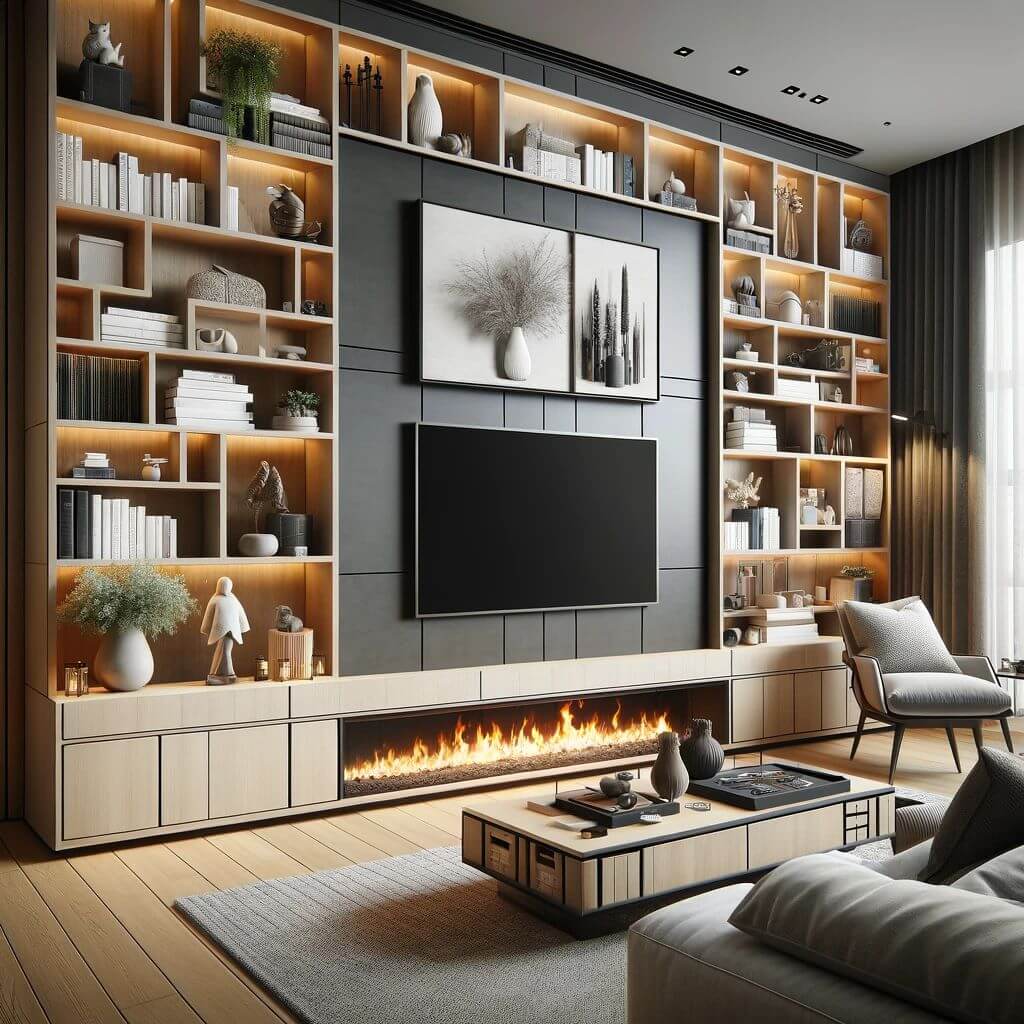
- Improved Efficiency: Modern fireplaces, particularly gas and electric models, offer higher efficiency with less heat loss. Innovations in insulation and materials also contribute to better heat retention and output.
- Smart Features: Integration with home automation systems for remote control of temperature, flame size, and even LED lighting to simulate a fire.
- Customizable Designs: Advances in manufacturing have allowed for customizable fireplace designs, including modular units that can fit various spaces and aesthetics.
Environmental Considerations and Energy Efficiency
- Eco-Friendly Fuels: The use of bioethanol and pellets offers environmentally friendly alternatives to traditional wood-burning models. These fuels burn cleaner and are renewable.
- Emission Reduction: Modern wood-burning fireplaces and stoves are designed to reduce emissions, meeting stringent environmental standards set in many countries.
- Heat Recovery Systems: Some advanced models include heat recovery systems that distribute excess heat throughout the home, improving overall energy use.
Last words on difference between parts of a chimney and fireplace
Understanding the different parts of chimneys and fireplaces is crucial for homeowners, not only for the safe and efficient operation of these heating systems but also for appreciating their role in the overall design and ambiance of a home. From the traditional warmth of a wood-burning hearth to the sleek convenience of modern gas or electric fireplaces, these fixtures blend functionality, design, and safety in unique ways, contributing to both the comfort and aesthetic appeal of living spaces.
The architecture of chimney and fireplace systems is a sophisticated blend of engineering and design. Every component, from the firebox to the chimney cap, plays a vital role in ensuring efficient operation and safety. Regular maintenance and understanding common issues are key to the longevity and proper functioning of these systems. Moreover, with advancements in technology and a growing emphasis on sustainability, fireplaces and chimneys continue to evolve, offering enhanced efficiency, lower emissions, and integration with modern home designs.
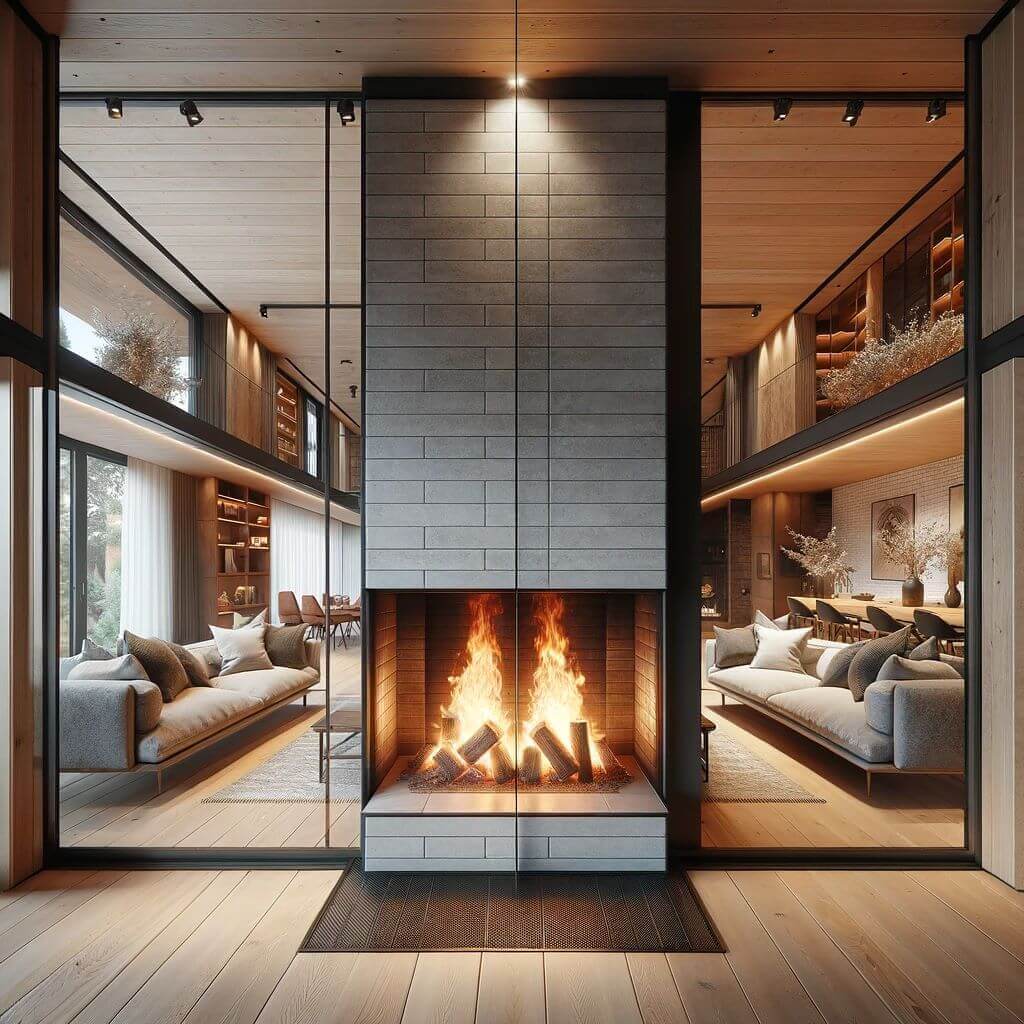
FAQ Chimney vs Fireplace
- How often should I have my chimney inspected and cleaned?
- It is recommended to have your chimney inspected and cleaned at least once a year, preferably before the start of the heating season.
- What are the signs that my fireplace needs maintenance?
- Indicators include difficulty in starting a fire or keeping it burning, smoke entering the room, a strong smell of smoke, and visible soot or creosote buildup.
- Can I install a gas or electric fireplace in a home that currently has a wood-burning fireplace?
- Yes, it is often possible to install a gas or electric insert into an existing wood-burning fireplace. However, this should be done by a professional to ensure proper installation and ventilation.
- Are there environmentally friendly options for fireplaces?
- Yes, options like electric fireplaces, gas fireplaces with low emissions, and wood-burning stoves that meet EPA emissions standards are considered more environmentally friendly.
- How can I improve the energy efficiency of my fireplace?
- Installing glass doors, ensuring proper insulation, using a fireplace insert, and regular maintenance can improve the efficiency of your fireplace.
- Is it safe to leave a fireplace running overnight?
- For wood-burning fireplaces, it’s not recommended due to the risk of sparks or embers. For gas and electric fireplaces, follow the manufacturer’s guidelines regarding extended use.
- What should I do if I notice cracks in my fireplace or chimney?
- Cracks can be a sign of structural issues and should be inspected by a professional as soon as possible to determine the best course of action.



